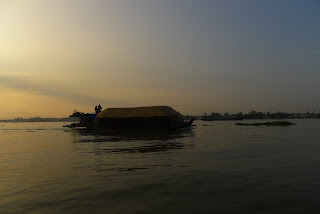The first impression of the capital is really likeable.
There is a great food, bar and coffee shop scene. A pearl to discover indeed!
The cathedral, some French dabs...
The central post office. We shipped a parcel to Switzerland, let's see who arrives first: the parcel or we?
Great (international) restaurants... mhhhh Japanese...
Sticky rice dessert paradise :-)
The Jade Emperor Pagoda, one of the most spectacular and atmospheric temples in Ho Chi Minh City, stuffed with statues of
phantasmal divinities and grotesque heroes. The pungent smoke of incense fills the air, obscuring the exquisite woodcarvings.
Traffic is a big issue in every bigger city...
Visiting Ho Chi Minh without a history class is impossible. Vietnam has an emotional past. The people suffered a lot. The War Remnants Museum provides excellent elucidation.
Also the Independence Palace (or Reunification Palace), built on the site of the former Norodom Palace, is a landmark in Ho Chi Minh and Vietnamese history. It was the home and workplace of the President of South Vietnam during the Vietnam war. It was the site of the end of the Vietnam War during the Fall of Saigon on April 30, 1975, when a North Vietnam Army tank crashed through its gates.
The inside with its typical 60ies architecture...
Another historic site are the Cu Chi Tunnels about 40 km northwest of Ho Chi Minh City. The Cu Chi Tunnels are an elaborate underground community made up of 250 km of tunnels and chambers below the city. Tourists can visit the site though just 120 meters are publicly accessible. The tunnels are so small, that they have been enlarged for tourists - though they are really tiny!
The tunnels were dug with simple tools and bare hands during the French
occupation in the 1940s, and further expanded during the Vietnam War in
the 1960s to provide refuge and a defensive advantage over the American
soldiers. Despite all the bombings in their town, the Cu Chi people were
able to continue their lives beneath the soil, where they slept, ate,
planned attacks, healed their sick, and taught their young. Some even
wed and gave birth underground, but over 10,000 lost their lives here.
A tunnel entry. Hidden in the forest under the leaves...
Vietnamese also used a lot of self-made "natural" traps to fight and protect their village... Bamboo spines hidden in a trap door.

















































